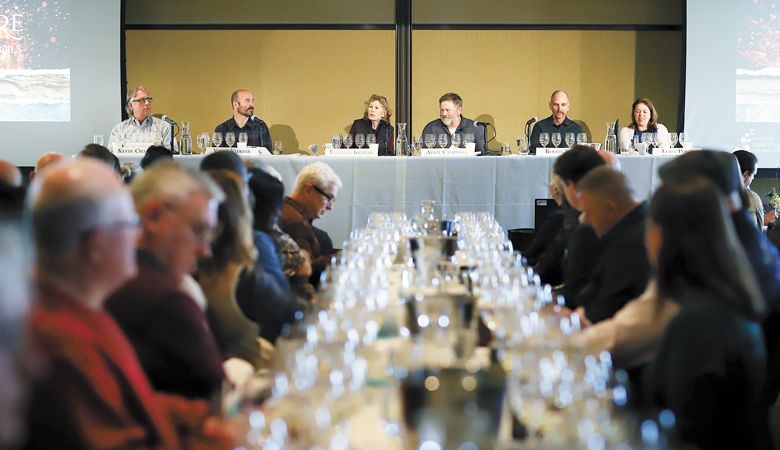Of Flood and Fire
Chardonnay explored through soil
We [in Oregon] haven’t had a Chardonnay evolution; we’ve had a Chardonnay revolution.” With these words, Eugenia Keegan, the Oregon general manager of Jackson Family Wines, opened the ninth annual Oregon Chardonnay Celebration, Feb. 22, at the Allison Spa & Inn in Newberg.
Keegan was comparing Oregon Chardonnay with Oregon Pinot Noir, regarding the timeframe and degree of difficulty bringing the latter to the international stage.
“It is a true pleasure to travel the world, present as an Oregon winemaker and receive immediate recognition for what we are doing in this wine region. While the reputation for Oregon Pinot Noir was built over the past 50 years, international credibility for Oregon Chardonnay is on a fast track, turning heads in less than 10.”
It is no accident.
“Our winemaking community deliberately took control of the process and created opportunities to quickly evolve the quality of Oregon Chardonnay,” shared Keegan.
For the past seven years, winemakers have gathered for a Chardonnay technical seminar geared toward understanding how terroir, and vineyard and cellar choices impact the finished wines. Controlled experimental samples reveal the individual impact of these factors. In addition, approximately 90 barrel samples are tasted blind in a two-hour, self-guided learning format. Picture more than a hundred winemakers armed with detailed data sheets — disclosing clones, soils, picking parameters, cellar practices, etc. — tasting different Chardonnays in an in-depth comparison.
Compare this warp-speed learning to the years of trial and error required by individual winemaker experimenting vintage by vintage. Winemakers needing advice on managing tannins can taste different methods side by side. People making decisions about the impact of soils on finished wine can taste those comparisons in a single day before diversifying their own plantings. Winemakers leave with a clearer understanding of how to create the highest quality Chardonnay from their sites.
“Winegrowers in less collaborative regions can’t wrap their minds around this level of cooperation,’’ Keegan shared proudly.
Participants at the Oregon Chardonnay Celebration benefited from a tiny taste of targeted Chardonnay education. The theme, “Born of Flood and Fire,” represented an exploration of Chardonnay from the state’s unique vineyard soils. Kevin Chambers of Koosah Farm presented an overview of geological events that included floods, fires, earthquakes and the shifting of land and sea to create Oregon’s soils and landscape, over millions of years. Along with their insights, participants from key wineries shared tastes of Chardonnay from different soils.
Winemaker Vince Vidrine, of Irvine & Roberts Vineyards, began the comparative panel tasting with examples from the Rogue Valley estate. Represented in the glass were wines from non-marine sedimentary soils consisting of Darow silty loam, rich in nutrients with excellent drainage. Vidrine stated candidly that the learning process continues for how these soils affect the finished wines.
Vidrine says low-clay soils tend to result in lower tannins compared to wines made in the same way from more easily draining soils. He describes the wines from Darow as balanced with a propensity of “wildflower, honey, pear and white peach” flavors. Panel wines tasted: Irvine & Roberts Vineyards 2017 Estate and 2017 Reserve Chardonnay
Adam Campbell, of Elk Cove Vineyards, shared how Chardonnay from Goodrich Vineyard, in part, sparked his interest in the grape. He eventually expanded Chardonnay plantings on the site; situated in the Yamhill-Carlton AVA, the vines grow in ancient marine sedimentary Willakenzie soils. Campbell picks for acidity and lower alcohol, managing tannin during the press cycle. He finds the soils contribute to “fresh, bright Chardonnay with flavors of lemon-lime and lemon curd, plus a flinty structure.” Panel wines tasted: Elk Cove Vineyards 2014 and 2016 Goodrich Vineyard Chardonnay
Rollin Soles, of ROCO Winery, is one of the founders of Oregon’s first Chardonnay collective, the Oregon Chardonnay Alliance. Soles has been crafting Willamette Valley Chardonnay for 34 years. He pointed out how Knudsen Vineyards benefits from the higher-water holding capacity because of its Dundee Hills Jory soils.
“With Jory, you learn to trust the climate,” he explained. These deeper volcanic soils act like a buffer to hotter and drier growing seasons. The soils usually hold enough water late in the season, allowing roots to absorb nitrogen needed to develop fruit aroma and flavor molecules in Chardonnay. He finds volcanic Jory soils contribute to more “pear and primary fruit flavors” instead of the “mineral and oyster shell” notes from marine sedimentary soils. Panel Wines Tasted ROCO Winery 2015 and 2017 Knudsen Vineyard Chardonnay
Though Ponzi Vineyards has been making Chardonnay since 1974, Luisa Ponzi became enamored with the varietal when working and attending school in Burgundy. She continued her pioneering work with Dijon clones upon her 1993 return to the family vineyards in Oregon.
A proponent of the uniqueness of Laurelwood soils, she says Chardonnay from the winery’s Chehalem Mountain AVA site offers “citrus, jasmine, magnolia, warm spice, fennel, salinity and oyster shell” notes. Further, she addressed the importance of the depth of top soils and age of the vines in layered soils. Based on observations from Ponzi’s estate fruit, “young vines in windblown sedimentary top soils are generously fruit-forward. After 10 to 15 years, the roots reach the deeper basalt soils and the wines magically increase in structure, finesse, salinity, floral and spice.” Panel wines tasted Ponzi Vineyards 2017 Avellana and 2017 Aurora Chardonnay
An immersive tasting of more than 50 featured wineries followed the panel discussion, which in itself, is a testament to the growth of Oregon Chardonnay. “When this event began, 20 wineries poured at the Grand Tasting,” Keegan recalled. “Nine years [later], the selection committee has to narrow the featured wineries from 180-plus submissions.”
For more about the Oregon Chardonnay Celebration, including next year’s dates, visit www.oregonchardonnaycelebration.org.










